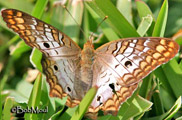Native Plants
Search for native plants by scientific name, common name or family. If you are not sure what you are looking for, try the Combination Search or our Recommended Species lists.
Bacopa monnieri
Bacopa monnieri (L.) Pennell
Herb-of-grace, Water Hyssop, Coastal Water-hyssop
Scrophulariaceae (Figwort Family)
Synonym(s): Bramia monnieri, Lysimachia monnieri
USDA Symbol: bamo
USDA Native Status: L48 (N), HI (N), PR (N), VI (N)
The solitary, axillary, bell-shaped flowers of these creeping, mat-forming, aquatic or semi-aquatic perennials are borne on slender pedicils. The small, white flowers are often tinged with blue or pink. The leaves are small, oval and shiny.
Water Hyssop is a member of the figwort or snapdragon family (family Scrophulariaceae), which includes about 220 genera and 3,000 species occurring nearly throughout the world.
Plant Characteristics
Duration: PerennialHabit: Herb
Fruit Type: Capsule
Size Notes: Prostrate stems up to about 1 foot long.
Bloom Information
Bloom Color: White , Pink , BlueBloom Time: Apr , May , Jun , Jul , Aug , Sep
Distribution
USA: AL , AZ , CA , FL , GA , HI , LA , MD , MS , NC , OK , SC , TX , VANative Distribution: Coastal Plain from MD to TX & s.w. AR
Native Habitat: Wet sands; mud flats; pond or stream margins
Growing Conditions
Water Use: HighLight Requirement: Sun , Part Shade
Soil Moisture: Moist , Wet
Soil Description: Wet sands.
Conditions Comments: Water-hyssop is a good choice to plant in bogs,water gardens and in hanging baskets or draping over the edge of a pot. It will also grow in moist soil or shallow water as a groundcover. The small, white flowers are often tinged with blue or pink. The leaves are small, oval and shiny.
Benefit
Conspicuous Flowers: yesAttracts: Butterflies
Deer Resistant: Moderate
Butterflies and Moths of North America (BAMONA)
|
White Peacock (Anartia jatrophae)  Larval Host |
Propagation
Propagation Material: Clump DivisionDescription: Very easy to grow water plant. Pick off trailing stems with roots and replant. Might look more lush if roots were kept wet, but does fine outside tanks too.
National Wetland Indicator Status
| Region: | AGCP | AK | AW | CB | EMP | GP | HI | MW | NCNE | WMVE |
| Status: | OBL | OBL | OBL | OBL | OBL | OBL |
From the National Organizations Directory
According to the species list provided by Affiliate Organizations, this plant is on display at the following locations:Fredericksburg Nature Center - Fredericksburg, TX
Lady Bird Johnson Wildflower Center - Austin, TX
Nueces River Authority - Uvalde, TX
Wildflower Center Seed Bank
LBJWC-1096 Collected 2007-08-10 in Montgomery County by Lady Bird Johnson Wildflower CenterBibliography
Bibref 1186 - Field Guide to Moths of Eastern North America (2005) Covell, C.V., Jr.Bibref 1185 - Field Guide to Western Butterflies (Peterson Field Guides) (1999) Opler, P.A. and A.B. Wright
Search More Titles in Bibliography
Web Reference
Webref 38 - Flora of North America (2019) Missouri Botanical Garden, St. Louis, MO & Harvard University Herbaria, Cambridge, MA.Webref 23 - Southwest Environmental Information Network (2009) SEINet - Arizona Chapter
Additional resources
USDA: Find Bacopa monnieri in USDA PlantsFNA: Find Bacopa monnieri in the Flora of North America (if available)
Google: Search Google for Bacopa monnieri
Metadata
Record Modified: 2023-05-17Research By: TWC Staff, RLU